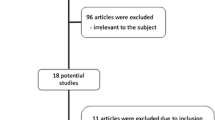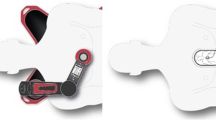Abstract
Purpose
Assessment of hemodynamics is crucial for the evaluation of major trauma patients. Cardiac output (CO) monitoring provides additional information and may improve volume resuscitation. The goal of this prospective pilot study was to evaluate the feasibility of a new non-invasive CO monitoring (NICOM) device in the emergency department (ED).
Methods
Single-center prospective observational pilot study including 20 trauma patients admitted to a level 1 trauma center. CO was continuously monitored for 60 min after ED admission using the new NICOM device ICON®. This device measures changes of the thoracic bioimpedance to calculate CO. Conventional vital signs were recorded simultaneously. Feasibility, safety, reliability, user-friendliness, and impact of the device on standard ED procedures were assessed.
Results
Thirteen (65%) patients were male, median age was 57.5 (IQR 25), and median ISS was 10.5 (IQR 14.8). Median CO over time was 9.8 l/min (IQR 4.6). No adverse effects were recorded. The device proved to be user-friendly with no negative impact on routine ED care. In four patients, detachment of electrodes was observed, and in four patients, the CO recording was temporary discontinued. Short-term changes of the CO were observed 44 times after the placement of electrodes and during patient transfers.
Conclusions
Non-invasive CO monitoring proved to be feasible and safe for the initial hemodynamic evaluation of trauma patients. Problems with the NICOM device were detachment of electrodes and temporary signal loss. Due to the small sample size and relatively low injury burden of the patients included in this study, further prospective investigation is warranted.




Similar content being viewed by others
References
Kauvar DS, Lefering R, Wade CE. Impact of hemorrhage on trauma outcome: an overview of epidemiology, clinical presentations, and therapeutic considerations. J Trauma. 2006;60(6 Suppl):3–11. https://doi.org/10.1097/01.ta.0000199961.02677.19.
Dunham CM, Chirichella TJ, Gruber BS, Ferrari JP, Martin JA, Luchs BA, et al. Emergency department noninvasive (NICOM) cardiac outputs are associated with trauma activation, patient injury severity and host conditions and mortality. J Trauma Acute Care Surg. 2012;73(2):479–85.
Velmahos GC, Wo CC, Demetriades D, Shoemaker WC. Early continuous noninvasive haemodynamic monitoring after severe blunt trauma. Injury. 1999;30(3):209–14.
Velmahos GC, Wo CC, Demetriades D, Murray JA, Cornwell EE 3rd, Asensio JA, et al. Invasive and non-invasive physiological monitoring of blunt trauma patients in the early period after emergency admission. Int Surg. 1999;84(4):354–60.
Tatevossian RG, Shoemaker WC, Wo CC, Dang AB, Velmahos GC, Demetriades D. Noninvasive hemodynamic monitoring for early warning of adult respiratory distress syndrome in trauma patients. J Crit Care. 2000;15(4):151–9. https://doi.org/10.1053/jcrc.2000.19235.
Shoemaker WC, Wo CC, Chien LC, Lu K, Ahmadpour N, Belzberg H, et al. Evaluation of invasive and noninvasive hemodynamic monitoring in trauma patients. J Trauma. 2006;61(4):844–53. https://doi.org/10.1097/01.ta.0000197925.92635.56. (discussion 53–4).
Shoemaker WC, Wo CC, Chan L, Ramicone E, Kamel ES, Velmahos GC, et al. Outcome prediction of emergency patients by noninvasive hemodynamic monitoring. Chest. 2001;120(2):528–37.
Lu KJ, Chien LC, Wo CC, Demetriades D, Shoemaker WC. Hemodynamic patterns of blunt and penetrating injuries. J Am Coll Surg. 2006;203(6):899–907. https://doi.org/10.1016/j.jamcollsurg.2006.08.004.
Colombo J, Shoemaker WC, Belzberg H, Hatzakis G, Fathizadeh P, Demetriades D. Noninvasive monitoring of the autonomic nervous system and hemodynamics of patients with blunt and penetrating trauma. J Trauma. 2008;65(6):1364–73. https://doi.org/10.1097/TA.0b013e31818cc307.
Bishop MH, Shoemaker WC, Appel PL, Wo CJ, Zwick C, Kram HB, et al. Relationship between supranormal circulatory values, time delays, and outcome in severely traumatized patients. Crit Care Med. 1993;21(1):56–63.
Compton F, Schafer JH. Noninvasive cardiac output determination: broadening the applicability of hemodynamic monitoring. Semin Cardiothorac Vasc Anesth. 2009;13(1):44–55. https://doi.org/10.1177/1089253208330711.
Pugsley J, Lerner AB. Cardiac output monitoring: is there a gold standard and how do the newer technologies compare? Seminars in cardiothoracic and vascular anesthesia. 2010;14(4):274–82. https://doi.org/10.1177/1089253210386386.
Chamos C, Vele L, Hamilton M, Cecconi M. Less invasive methods of advanced hemodynamic monitoring: principles, devices, and their role in the perioperative hemodynamic optimization. Perioper Med. 2013;2(1):19. https://doi.org/10.1186/2047-0525-2-19.
Raaijmakers E, Faes TJ, Scholten RJ, Goovaerts HG, Heethaar RM. A meta-analysis of three decades of validating thoracic impedance cardiography. Crit Care Med. 1999;27(6):1203–13.
Shoemaker WC, Belzberg H, Wo CC, Milzman DP, Pasquale MD, Baga L, et al. Multicenter study of noninvasive monitoring systems as alternatives to invasive monitoring of acutely ill emergency patients. Chest. 1998;114(6):1643–52.
Brown CV, Shoemaker WC, Wo CC, Chan L, Demetriades D. Is noninvasive hemodynamic monitoring appropriate for the elderly critically injured patient? J Trauma. 2005;58(1):102–7.
Bishop MH, Shoemaker WC, Shuleshko J, Wo CC. Noninvasive cardiac index monitoring in gunshot wound victims. Acad Emerg Med. 1996;3(7):682–8.
Martin M, Brown C, Bayard D, Demetriades D, Salim A, Gertz R, et al. Continuous noninvasive monitoring of cardiac performance and tissue perfusion in pediatric trauma patients. J Pediatr Surg. 2005;40(12):1957–63. https://doi.org/10.1016/j.jpedsurg.2005.08.017.
Bernstein DPOM. Apparatus and method for determining an approximation of the stroke volume and the cardiac output of the heart. US Patent 6,511,438 B2. January 28, 2003.
Schmidt C, Theilmeier G, Van Aken H, Korsmeier P, Wirtz SP, Berendes E, et al. Comparison of electrical velocimetry and transoesophageal Doppler echocardiography for measuring stroke volume and cardiac output. Br J Anaesth. 2005;95(5):603–10. https://doi.org/10.1093/bja/aei224.
Rauch R, Welisch E, Lansdell N, Burrill E, Jones J, Robinson T, et al. Non-invasive measurement of cardiac output in obese children and adolescents: comparison of electrical cardiometry and transthoracic Doppler echocardiography. J Clin Monit Comput. 2013;27(2):187–93. https://doi.org/10.1007/s10877-012-9412-7.
Norozi K, Beck C, Osthaus WA, Wille I, Wessel A, Bertram H. Electrical velocimetry for measuring cardiac output in children with congenital heart disease. Br J Anaesth. 2008;100(1):88–94. https://doi.org/10.1093/bja/aem320.
Zoremba N, Bickenbach J, Krauss B, Rossaint R, Kuhlen R, Schalte G. Comparison of electrical velocimetry and thermodilution techniques for the measurement of cardiac output. Acta Anaesthesiol Scand. 2007;51(10):1314–9. https://doi.org/10.1111/j.1399-6576.2007.01445.x.
Flinck M, Graden A, Milde H, Flinck A, Hellstrom M, Bjork J, et al. Cardiac output measured by electrical velocimetry in the CT suite correlates with coronary artery enhancement: a feasibility study. Acta Radiol. 2010;51(8):895–902. https://doi.org/10.3109/02841851.2010.503663.
Osypka MJ, Bernstein DP. Electrophysiologic principles and theory of stroke volume determination by thoracic electrical bioimpedance. AACN Clin Issues. 1999;10(3):385–99.
Author information
Authors and Affiliations
Contributions
MK planned the study protocol, conducted the clinical data collection, assisted in the statistical analysis of data, drafted and composed the manuscript. TH participated in the planning of the study protocol, performed the statistical analysis of data, and revised the manuscript critically. AE revised the manuscript critically. BS conceived the study, participated in the planning of the study protocol, and revised the manuscript critically. All authors read and approved the final manuscript.
Corresponding author
Ethics declarations
Conflict of interest
Matthias Kuster, Tobias Haltmeier, Aristomenis Exadaktylos, and Beat Schnüriger declare that they have no conflict of interest or financial ties.
Ethical approval
This study was approved by the cantonal ethics committee of Bern, Switzerland (KEK No. 353/2015). All procedures performed in studies involving human participants were in accordance with the ethical standards of the institutional and/or national research committee and with the 1964 Helsinki declaration and its later amendments or comparable ethical standards.
Informed consent
Informed consent was obtained from all individual participants included in the study.
Rights and permissions
About this article
Cite this article
Kuster, M., Haltmeier, T., Exadaktylos, A. et al. Non-invasive cardiac output monitoring device “ICON” in trauma patients: a feasibility study. Eur J Trauma Emerg Surg 45, 1069–1076 (2019). https://doi.org/10.1007/s00068-018-0984-x
Received:
Accepted:
Published:
Issue Date:
DOI: https://doi.org/10.1007/s00068-018-0984-x




